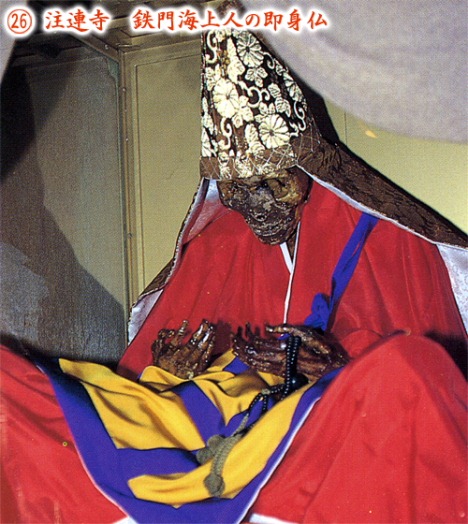Scattered throughout Northern Japan around the Yamagata
Prefecture are two dozen mummified Japanese monks known as Sokushinbutsu, who
caused their own deaths in a way that resulted in their mummification. The
practice was first pioneered by a priest named Kuukai over 1000 years ago at
the temple complex of Mount Koya, in Wakayama prefecture. Kuukai was founder of
the Shingon sect of Buddhism, which is the sect that came up with the idea of
enlightenment through physical punishment. A successful mummification took
upwards of ten years. It is believed that many hundreds of monks tried, but
only between 16 and 24 such mummifications have been discovered to date.
The elaborate process started with 1,000 days of eating a
special diet consisting only of nuts and seeds, while taking part in a regimen
of rigorous physical activity that stripped them of their body fat. They then
ate only bark and roots for another thousand days and began drinking a
poisonous tea made from the sap of the Urushi tree, normally used to lacquer
bowls.
 This caused vomiting and a rapid loss of bodily fluids, and
most importantly, it made the body too poisonous to be eaten by maggots.
Finally, a self-mummifying monk would lock himself in a stone tomb barely
larger than his body, where he would not move from the lotus position. His only
connection to the outside world was an air tube and a bell. Each day he rang a
bell to let those outside know that he was still alive.
This caused vomiting and a rapid loss of bodily fluids, and
most importantly, it made the body too poisonous to be eaten by maggots.
Finally, a self-mummifying monk would lock himself in a stone tomb barely
larger than his body, where he would not move from the lotus position. His only
connection to the outside world was an air tube and a bell. Each day he rang a
bell to let those outside know that he was still alive.
When the bell stopped ringing, the tube was removed and the
tomb sealed. After the tomb was sealed, the other monks in the temple would
wait another 1,000 days, and open the tomb to see if the mummification was
successful. If the monk had been successfully mummified, they were immediately
seen as a Buddha and put in the temple for viewing. Usually, though, there was
just a decomposed body.
The mummies also possess the accessories they had prior to
death. However, their eyes have been removed. Even so, they are considered able
to see into the souls of the living and be able to perceive reality perfectly.
The practice is now outlawed by the government of Japan and
not practiced today by any Buddhist sect.


No comments:
Post a Comment